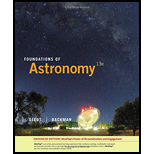
Foundations of Astronomy, Enhanced
13th Edition
ISBN: 9781305980686
Author: Michael A. Seeds; Dana Backman
Publisher: Cengage Learning US
expand_more
expand_more
format_list_bulleted
Textbook Question
Chapter 24, Problem 2DQ
Suggest a single phenomenon that could explain the inclination of the rotation axis of Uranus, the peculiar orbits of Neptune’s major satellites, and the existence of Pluto’s moons.
Expert Solution & Answer
Want to see the full answer?
Check out a sample textbook solution
Students have asked these similar questions
pls help on all
6.
As the distance between two charges decreases, the magnitude of the electric potential energy of the
two-charge system:
a) Always increases
b) Always decreases
c)
Increases if the charges have the same sign, decreases if they have the opposite signs
d) Increases if the charges have the opposite sign, decreases if they have the same sign
7.
To analyze the motion of an elastic collision between two charged particles we use conservation of
&
a)
Energy, Velocity
b)
Momentum, Force
c)
Mass, Momentum
d)
Energy, Momentum
e)
Kinetic Energy, Potential Energy
pls help on all asked questions kindly
Chapter 24 Solutions
Foundations of Astronomy, Enhanced
Ch. 24 - Why didnt ancient astronomers know of Uranuss...Ch. 24 - Describe the location of the equinoxes and...Ch. 24 - Prob. 3RQCh. 24 - Prob. 4RQCh. 24 - Why is belt-zone circulation difficult to detect...Ch. 24 - Prob. 6RQCh. 24 - Prob. 7RQCh. 24 - Describe four characteristics in common among all...Ch. 24 - Describe four differences between the two ice...Ch. 24 - Prob. 10RQ
Ch. 24 - What are hypotheses for the origin of the rings of...Ch. 24 - How do the characteristics of Uranuss and Neptunes...Ch. 24 - If Uranus and Neptune had no satellites at all,...Ch. 24 - Why might the surface brightness of ring particles...Ch. 24 - Both Uranus and Neptune have a blue-green tint...Ch. 24 - How are the atmospheres of Earth and Triton...Ch. 24 - Prob. 17RQCh. 24 - When Neptune was discovered, how was its position...Ch. 24 - How can small worlds like Triton and Pluto have...Ch. 24 - Why do you suspect that Triton had a geologically...Ch. 24 - If you visited the surface of Pluto and found...Ch. 24 - What evidence can you give that Pluto and Charon...Ch. 24 - Why was Pluto reclassified as a dwarf planet?Ch. 24 - How was the discovery of Neptune not accidental?Ch. 24 - Prob. 1DQCh. 24 - Suggest a single phenomenon that could explain the...Ch. 24 - Prob. 3DQCh. 24 - Prob. 4DQCh. 24 - Prob. 5DQCh. 24 - What is the maximum angular diameter of Uranus as...Ch. 24 - One way to recognize a distant planet is by...Ch. 24 - What is the orbital velocity of Miranda around...Ch. 24 - Calculate Uranuss Roche radius. Are all of Uranuss...Ch. 24 - Prob. 5PCh. 24 - What is the escape velocity from the surface of an...Ch. 24 - What is the difference in the orbital velocities...Ch. 24 - Repeat Problem 2 for Pluto. In other words,...Ch. 24 - Given the size of Tritons orbit (r = 355,000 km)...Ch. 24 - Prob. 1LTLCh. 24 - Prob. 2LTLCh. 24 - Compare the interior cutaway sketches of the four...Ch. 24 - Prob. 4LTLCh. 24 - Review Figure 21-11. Which molecules can Triton...Ch. 24 - The image to the left shows how Uranus would look...
Knowledge Booster
Learn more about
Need a deep-dive on the concept behind this application? Look no further. Learn more about this topic, physics and related others by exploring similar questions and additional content below.Similar questions
- pls help on all asked questions kindlyarrow_forward17. Two charges, one of charge +2.5 × 10-5 C and the other of charge +3.7 × 10-6 C, are 25.0 cm apart. The +2.5 × 10−5 C charge is to the left of the +3.7 × 10−6 C charge. a. Draw a diagram showing the point charges and label a point Y that is 20.0 cm to the left of the +3.7 × 10-6 C charge, on the line connecting the charges. (Field lines do not need to be drawn.) b. Calculate the net electric field at point Y.arrow_forward3arrow_forward
- Set ба ||Axl 49.32 6b 71 Ay 22 Magnitude of A Angle of A 24.04 Angle of -A 22 54 155.96 ° (pos Ax) 204.04 ° (neg Ax) 335.96 ° (pos Ax) ° (neg Ax) 115.77 ° (pos Ax) 295.77 ° (pos Ax) -39 81 208.78 ° (neg Ax) 28.78 ° (neg Ax)arrow_forward3AA . not sure what i am getting wrongarrow_forward6barrow_forward
arrow_back_ios
SEE MORE QUESTIONS
arrow_forward_ios
Recommended textbooks for you
 Foundations of Astronomy (MindTap Course List)PhysicsISBN:9781337399920Author:Michael A. Seeds, Dana BackmanPublisher:Cengage Learning
Foundations of Astronomy (MindTap Course List)PhysicsISBN:9781337399920Author:Michael A. Seeds, Dana BackmanPublisher:Cengage Learning

 AstronomyPhysicsISBN:9781938168284Author:Andrew Fraknoi; David Morrison; Sidney C. WolffPublisher:OpenStax
AstronomyPhysicsISBN:9781938168284Author:Andrew Fraknoi; David Morrison; Sidney C. WolffPublisher:OpenStax An Introduction to Physical SciencePhysicsISBN:9781305079137Author:James Shipman, Jerry D. Wilson, Charles A. Higgins, Omar TorresPublisher:Cengage Learning
An Introduction to Physical SciencePhysicsISBN:9781305079137Author:James Shipman, Jerry D. Wilson, Charles A. Higgins, Omar TorresPublisher:Cengage Learning Physics for Scientists and Engineers with Modern ...PhysicsISBN:9781337553292Author:Raymond A. Serway, John W. JewettPublisher:Cengage Learning
Physics for Scientists and Engineers with Modern ...PhysicsISBN:9781337553292Author:Raymond A. Serway, John W. JewettPublisher:Cengage Learning

Foundations of Astronomy (MindTap Course List)
Physics
ISBN:9781337399920
Author:Michael A. Seeds, Dana Backman
Publisher:Cengage Learning



Astronomy
Physics
ISBN:9781938168284
Author:Andrew Fraknoi; David Morrison; Sidney C. Wolff
Publisher:OpenStax

An Introduction to Physical Science
Physics
ISBN:9781305079137
Author:James Shipman, Jerry D. Wilson, Charles A. Higgins, Omar Torres
Publisher:Cengage Learning

Physics for Scientists and Engineers with Modern ...
Physics
ISBN:9781337553292
Author:Raymond A. Serway, John W. Jewett
Publisher:Cengage Learning
Kepler's Three Laws Explained; Author: PhysicsHigh;https://www.youtube.com/watch?v=kyR6EO_RMKE;License: Standard YouTube License, CC-BY